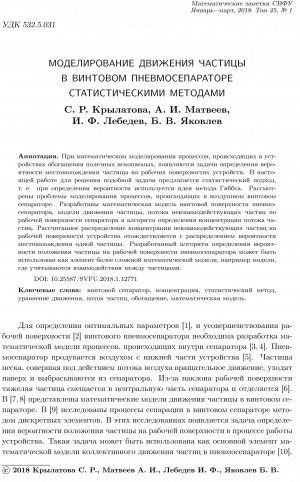В статье приводятся результаты проведенных многолетних исследований в области воздушного (сухого) способа разделения (обогащения) минералов полезных ископаемых. Даны результаты изготовленного пневматического сепаратора типа ПОС-2000, который прошел опытно-промышленные испытания в ряде золотосодержащих рудных месторождений Якутии и Амурской области. В работе описаны наработки по совершенствованию конструкционных и производственных параметров установки, где актуальным и востребованным в данное время, особенно для мобильных передвижных вариантов обогатительных установок, является уменьшение массогабаритных параметров. В статье показаны лабораторные экспериментальные работы, направленные на детализованное изучение особенностей динамики поведения многофазных сред в сложных камерах как в упрощенных ламинарных, так и в турбулентных случаях. Для более детального изучения влияния различного воздушного потока на процесс разделения различных минералов по плотности и крупности собрана экспериментальная лабораторная установка с тремя тороидальными зонами, состоящая из гибкой прозрачной пластиковой армированной трубы, изогнутой в виде винта (винтовой геликоид). Рассмотрены предельные углы подъёма частиц по внутренней границе лабораторного стенда, скорости витания частиц в зависимости от плотности и размеров, предельные углы зависания и витания при разных воздушных скоростях. Проведены исследования распределения частиц в радиальном сечении на различных участках трубы (S1-S3), в которых получены угловые различия по распределению из-за разного уровня соотношений центробежной и гравитационных сил, при испытанных скоростях и радиусах поворота. Показаны дальнейшие исследования, направленные на возможность модификации существующего пневмосепаратора для уменьшения массогабаритов, и разработка нового типа центробежного пневмосепаратора.
The article presents the results of many years of research in the field of air (dry) method of separation (enrichment) of minerals. The results of a manufactured pneumatic separator of the POS-2000 type, which passed pilot tests in a number of gold ore deposits in Yakutia and the Amur region, are presented. The work presents developments to improve the design and production parameters of the installation, where reduction of weight and size parameters is relevant and in demand at this time, especially for mobile mobile versions of enrichment plants. The article shows laboratory experimental work aimed at a detailed study of the dynamics of the behavior of multiphase media in complex chambers, both in simplified laminar and turbulent cases. For a more detailed study of the influence of different air flow on the process of separating various minerals by density and size, an experimental laboratory installation with three toroidal zones was assembled, consisting of a flexible transparent plastic reinforced pipe, bent in the form of a screw (screw helicoid). The maximum angles of rise of particles along the internal boundary of the laboratory stand, the speed of soaring of particles depending on density and size, the maximum angles of hovering and soaring at different air speeds are considered. Studies have been carried out on the distribution of particles in the radial section in different sections of the pipe (S1-S3), in which angular differences in distribution were obtained due to different levels of the ratio of centrifugal and gravitational forces, at tested speeds and turning radii. Further research aimed at the possibility of modifying the existing pneumatic separator to reduce weight and size and the development of a new type of centrifugal pneumatic separator are shown. The work was carried out within the framework of the state assignment of the Ministry of Science and Higher Education of the Russian Federation (topic No. 0297-2021-0022 of the unified state information system for recording research, development and technological work for civil purposes No. 122011800089-2) using the equipment of the Center for Collective Use of the Federal research center "Yakut Scientific Center of the Siberian Branch of the Russian Academy of Sciences", grant No. 13. Center for collective use 21.0016.











